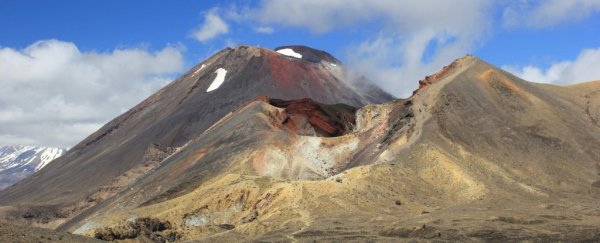Taupo is resting now, and for that we should all be very grateful.
The highly active Taupo Volcanic Zone, situated in New Zealand's North Island, produced history's most recent supereruption, unleashing some 530 cubic kilometres of fiery magma upon Earth's surface.
For context, what's widely regarded as the most destructive volcanic eruption in US history – the Mount St. Helens eruption of 1980 – only produced about 1 cubic kilometre. There is no comparison.
But in the lead-up to the devastating Oruanui supereruption in New Zealand, the Taupo Volcanic Zone produced a series of lesser explosions, spewing out seven smaller (but still massively powerful) eruptions over a period between 350,000 and 240,000 years ago.
By studying the lingering after-effects of these events many thousands of years later, scientists are closer to understanding what feeds a supervolcano's supereruption – or perhaps, more accurately, what doesn't.

The study, led by researchers from Vanderbilt University and Michigan Tech, shows how successive, frequent eruptions at volcanic calderas fundamentally change the magma activity hidden inside supervolcanoes.
"This massive outpouring of magma essentially drains the magmatic system over a relatively short period of time," says Michigan Tech volcanologist Chad Deering.
"However, following this activity, new magma rapidly ascends within the crust and primes it at shallow depths only to feed more large eruptions."
Led by volcanologist Guilherme Gualda from Vanderbilt University, Deering and fellow researchers studied layers of pumice visible in road cuts and other outcrops throughout the Taupo Volcanic Zone, measuring the amount of crystals in the samples they extracted.
The results suggest that after each successive eruption in the series leading up until 240,000 years ago – which each produced 50 to 150 cubic kilometres of magma – new magma deposits actually moved closer to the surface, climbing what the researchers characterise as a "crustal ladder".
"As the system resets, the deposits become shallower," Gualda explains.
"The crust is getting warmer and weaker, so magma can lodge itself at shallower levels."
While the magma draining of each eruption eases pressure inside the volcanic system – making supereruptions less likely – this crustal climbing effect could spur on other, smaller eruptions, as molten rock gets lodged in shallower and shallower chambers over the centuries and millennia.
"You have magma sitting there that's crystal-poor/melt-rich for a few decades, maybe 100 years and then it erupts," Gualda explains.
"Then another magma body is established, but we don't know how gradually that body assembles. It's a period in which you're increasing the amount of melt in the crust."
Just how long these geochemical processes take between eruptions is something that's still not fully understood, but the research is helping scientists to understand what conditions are necessary for a supereruption to occur.
While these events occur only very, very rarely, they're considered global disasters waiting to happen – the kind of nightmare scenario NASA estimates could be worse than a giant asteroid hitting the planet.
We could almost certainly never hope to stop something like this, but studying the magma buildup-and-release patterns over the course of smaller volcanic eruptions could at least give us a better idea of when to flee the planet.
"Given the magnitude of the potential impact of a supereruption on society, we suggest that monitoring of potentially restless calderas must include the specific search for clues that reveal mobilisation and storage of large quantities of magma on time frames of multiple years to decades," the researchers write in their paper.
The findings are reported in Science Advances.
